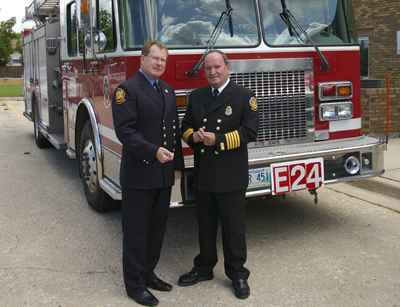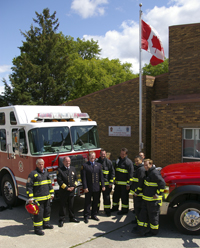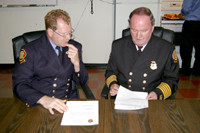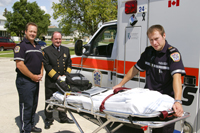
Features
Hot topics
Labour relations
Building bridges
Relationships are funny things. Psychologists, sociologists and academics have studied relationships and the problems that certain types of relationships create. The management/union relationship is one that has been extensively examined.
September 14, 2009
By Jay Shaw
Relationships are funny things. Psychologists, sociologists and academics have studied relationships and the problems that certain types of relationships create. The management/union relationship is one that has been extensively examined. There are courses on how to beat the union, how to beat management and how to win in negotiations without the other side knowing it has lost. There are numerous Canadian examples in which fire-service relationships with management are about as sweet as a bag of lemons.
 |
| Union president Alex Forrest (left) and Winnipeg Fire Paramedic Service Chief Jim Brennan have worked together to build a stronger department. They have succeeded in repairing a strained relationship and acquiring new SCBA and turn-out gear, and implementing a tiered response system. Photo by Bob Poole
|
For close to a decade firefighters in Winnipeg had a sour relationship with management that created numerous problems. Over several years and through one of the worst tragedies in the Canadian fire service in 2007, Winnipeg’s union/management relationship evolved into a partnership that is, arguably, the envy of Canadian fire departments. Getting there wasn’t easy. Here’s how it happened.
It was 1998, and an idea was reborn that would save money and provide better service in Winnipeg. Medical calls were going up and costs were skyrocketing. To ease the strain and create efficiencies, the Winnipeg Fire Department was disbanded by order of council. The amalgamation of all fire/rescue and EMS services was ordered and the operation was eventually named the Winnipeg Fire Paramedic Service. The concept made sense and looked promising in its simplicity – do more for less while creating a faster, smoother service to meet the needs of the new millennium.
But somebody forgot to tell the employees who, what, where, why and when. Planning focused on macro initiatives such as stations, equipment and dispatch. Other issues that may have seemed insignificant to management but were paramount to employees, such as lockers, beds and bathrooms, were never properly addressed or completely resolved. Nobody consulted anyone about how two different cultures were supposed to work side by side when they barely knew anything about each other. This caused considerable strife. Firefighters and paramedics wore the same uniforms but differed in skills, culture and history. Bickering was inevitable and relations that were already strained turned bitter and resentful.
 |
|
| Winnipeg Fire Paramedic Service members Capt. Ray Riddolls (left), Ed Pidwirny, Karl Hanzmann, acting Lt. Don Troschuk, Phil Moharb and Chad Moroz with Chief Jim Brennan and union president Alex Forrest. Photo by Bob Poole
|
The president of the United Fire Fighters of Winnipeg, Local 867, was then, and still is, Alex Forrest. He described the relationship between labour and administration as dysfunctional.
“At one point we had over 57 grievances on the table and there was no end in sight,” Forrest said.
Winnipeg Fire and Paramedic Chief Jim Brennan, who at the time was the deputy chief of support services, remembers those days as “progressively getting really bad, where the attitude eventually became, OK, we’ll just see you in court.”
As things got worse, both sides seemed to dig in their heels deeper and employee resentment became the norm. More energy was exerted fighting and planning individual battle strategies than on fixing everyday operational concerns.
Deputy Chief Brennan was tagged by former chief Wes Shoemaker as the “conscience of management”. He recalls wondering on many occasions why management was fighting some grievances that were unrelated to the core issue of amalgamation, such as taking senior fire officers out of scope. “With so many items on the table ” Brennan would often think, “We’re going to lose!”
Brennan and Forrest admit that both sides made mistakes. Brennan says a management error was to rely on consultants, people who really didn’t know much about the local scene.
“We tended to look outwards and say the way to do this is to copy another city, and that was wrong,” he says. “We would have done better to look at what we needed to do here and get it done, instead of looking for models to copy all over North America.
“The other thing we did wrong was that no one gave a lot of definition to anything. For example, the union would ask how many firefighters do you need cross trained as paramedics and management would reply, well we need a cadre. What the heck does that mean? To problem solve you need to be very specific and say things clearly, like we need 231.”
Forrest believes the union didn’t fully understand the impact of culture and how changing the name of the Winnipeg Fire Department would affect the membership and the day-to-day life in fire halls.
“We threw a lot of issues on the pile when we really should have concentrated on the biggest issue that faced this city in 15 years and that’s the increase in EMS calls,” he says.
Brennan and Forrest estimate that over the years millions of dollars were spent on lawyers and consultants during this negative period.
Things started to change in December 2006 when the former chief moved on and Brennan was made interim fire and paramedic chief. Forrest and Brennan never really had strained relations, due to Brennan’s support-services portfolio that kept him out of the mud for most of the battles. They began a working relationship that was on solid ground for the first time in years.
Winnipeg Mayor Sam Katz, who has witnessed the changes in both the department and the union / management relationship, says the fire service and its relationships with the union is healthy.
”I am very proud of the accomplishments that both the firefighters and paramedics have achieved under the leadership of Chief Brennan,” he says. “The whole team is working well, and that just wasn’t the case before.
Brennan, who was raised in Northern Ireland and immigrated to Canada in 1977, was very aware of cultural issues, as he had watched his country go through some rough times. Brennan was raised in a segregated community of Catholics and Protestants, where 3,000 people were killed and more than 40,000 wounded.
I lived through much of that,” he said. “When you have experience like that you tend to understand the impacts of culture very well. I understand why people get upset over a crest or a name. So for me, I did not have to feel like I was giving up concessions (to the union).”

|
|
|
Photo by Bob Poole
|
■ Tragedy spurs change
On Sunday, Feb. 4, 2007, on one of the coldest days of the year, the Winnipeg department lost captains Harold Lessard and Tom Nichols in a horrific house fire that injured four others, two of them critically. Brennan and Forrest met at the emergency room of the St. Boniface General Hospital where one of the captains was taken.
“We supported each other and went to the families together to tell them what had occurred,” Forrest remembers.
At that moment, the two became one unit that would lead their teams over the next few weeks through the challenging task of respectfully honouring the families’ wishes in a way that allowed a very public story to be shared with the city and country.
Imagine helping two families plan private funerals along with a public memorial for 10,000 that would allow a city to grieve along with thousands of firefighters and EMS personnel from all over North America, and do it in week, with two members still in critical condition, while keeping your own emotions in check.
With the clearance of doctors, one of the injured firefighters who was badly burned and faced months of recovery was moved to the 15,000-seat MTS Centre for the memorial service. Hospital staff practically created a hospital ward to facilitate a firefighter paying his respects to his fallen brothers. The military was brought in to help a march of thousands through the streets of Winnipeg. With lots of help from both teams, Brennan and Forrest pulled off a sincere and respectful tribute.
In the next six months Brennan became the full-time chief and, for the first time in the 125-year history of the Winnipeg Fire Department, a paramedic was at the wheel. In short order, there were considerable positive changes and both sides learned valuable lessons from a tragedy that devastated an organization. Both leaders allowed trust to be the cornerstone of a business relationship that had one goal – to serve the public the best way possible.
“We used to spend our time fighting and preparing for the battles,” Forrest says. “Now we’re spending time to understand the other person’s position, trying to find a win-win situation.”
Forrest admits that it’s sometimes difficult to envision solutions to problems when two sides have opposing views but he has learned to look hard at issues and identify and understand both sides’ goals, which has led to a better working relationship.
 |
|
| Morale at the Winnipeg Fire Paramedic Service is high and the two sectors have learned to work together under the direction of Chief Jim Brennan, shown here with paramedics (left) Brent Tierney and Bevan Barkman. Photo by Bob Poole |
Thirty months after Brennan was hired as interim chief the Winnipeg Fire Paramedic Service with its two branches – The Winnipeg Fire Department and the Winnipeg Emergency Medical Services – is effective and efficient and the union / management relationship is healthy and strong.
The accomplishments are considerable and include the first negotiated contract in many years between the United Fire Fighters of Winnipeg, Local 867, and management, new SCBA and turn-out gear, increases in occupational disease coverage and multiple new pieces of apparatus along with increased staffing in areas that were deemed not up to par in response times. In addition, the city has committed to build a new station and re-build three more in the next few years. Credit is due to Brennan and Forrest, their teams and a strengthened relationship with the provincial government that has contributed to many of the positive changes.
The crown jewel is a new tiered response system that properly identifies and dispatches the right resources to the right calls. This is possible by having licensed paramedic firefighters on 37 apparatus for the first time, thereby expanding the deployable resources while saving money. Some of those savings are being used to increase the training level of medics to include one ALS paramedic on every ambulance by the end of 2010. Without this new system the city would have had to immediately buy and staff 10 more ambulances at a cost of
$8.5 million.
“No one is saying that additional transport ambulances will not be needed as the population ages and grows but the immediacy of improved response times and increased dispatch flexibility are significant gains,” Brennan says.
Another positive: the service has turned its energy to customer-focused initiatives such as a thrombolytic therapy program that has reduced the death rate in certain cardiac emergencies to two per cent from eight per cent.
These numbers are all the evidence needed to support the benefits of open communication. Brennan can boast the best response times of licensed paramedics in Canada with a four-minute response 90 per cent of the time because Winnipeg’s fire trucks are getting to the scene quickly. “We used to send the closest ambulance, now we send the most appropriate unit whether BLS or ALS, as warranted,” he says.
“While we have focused upon the improved relationship between firefighters and their administration it is important to understand that paramedic union leaders of the period were also deeply instrumental in resolving a difficult period in the service’s history,” Brennan says. “Without their full and sincere co-operation the outcomes may well have been different.”
Brennan and Forrest know that the tragedy of Feb. 4, 2007, laid the groundwork for success; dropping the ball when the whole country was watching was not an option. They admit that being forced to deal with the deaths sped up a warming process that led to advances in the service.
It’s clear to observers that Brennan and Forrest have developed and consistently demonstrate the leadership skills and characteristics necessary to work through difficult times and institute change. Both praise their teams for working through those challenges. Still, Brennan and Forrest recognize that they will not always see eye to eye; when that happens, they put the issue aside and come back to it later with a fresh perspective.
Strong union / management relations allow departments to tackle other initiatives, such as Winnipeg’s recent bid to host the World Police & Fire Games in 2015. Brennan says the economic spin off for the city would have been in the $70-million range had the bid succeeded. “This type of project could never have been done without good labour relations,” he says.
Brennan and Forrest hope to leave a legacy of improved labour relations that will serve the next generation of leaders. In labour relations it’s natural for both sides to think the best way to achieve goals is to win battles. In Winnipeg, it’s not about winning; it’s about advancing joint initiatives that make sense operationally and financially.
Jay Shaw has been involved with emergency services and health care for 15 years as registered orthopaedic technologist, a rural ambulance attendant, a DND firefighter and, for the last seven years, a firefighter in Winnipeg. Shaw is enrolled in the bachelor of fire and life safety studies at the JIBC and is finishing his primary care paramedic training. He is also the life safety specialist, instructing fire and medical programs for the Southern Manitoba Academy of Response Training. Contact him at jayshaw@mts.net
Print this page